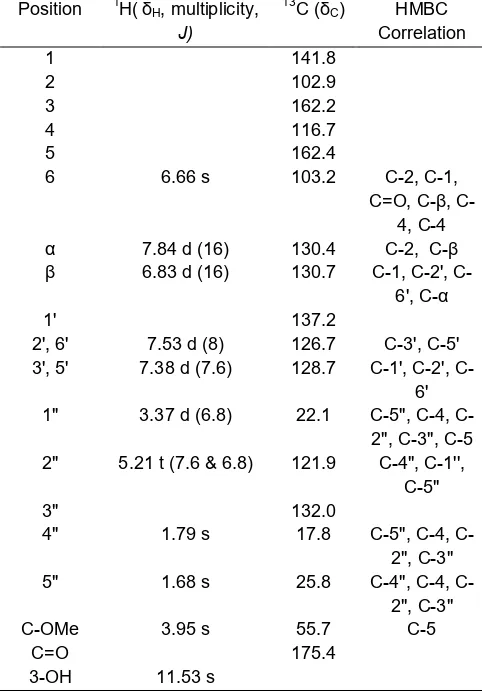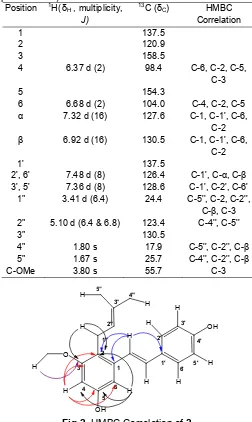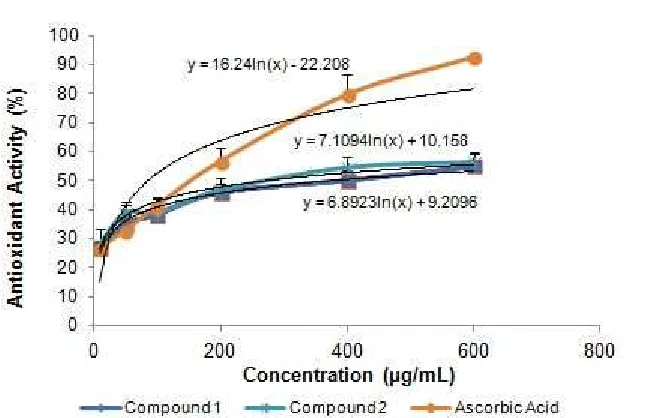New Prenylated Stilbenes and Antioxidant Activities
of
Cajanus cajan
(L.) Millsp. (Pigeon pea)
Taslim Ersam
*, Sri Fatmawati, and Dini Nur Fauzia
Department of Chemistry, Sepuluh Nopember Institute of Technology (ITS) Jl. Arief Rahman Hakim, Sukolilo, Surabaya 60111, Indonesia
Received October 2, 2015; Accepted May 9, 2016
ABSTRACT
New Prenylated stilbene derivatives, 3-hydroxy-4-prenyl-5-methoxy-stilbene acid (1) and 5,4'-dihydroxy-3-methoxy-2-prenyl-stilbene (2) had been isolated from methanol extract of Cajanus cajan (L.) Millsp. (Pigeon pea), a member of family fabaceae. The aim of this present work was to evaluate its in vitro antioxidant activity using 2,2-diphenyl-1-picryhydrazyl (DPPH) radical-scavenging. Isolation of compounds was achieved by extraction (maceration) and chromatographic technique. The structures of the compounds were determined based on UV, IR,
1
H-NMR and13C-NMR spectra and also by comparing with the previously reported data. Antioxidant activities (IC50)
of1and2 were 413.68 μg/mL and 271.53 μg/mL, respectively.
Keywords:Cajanus cajan (L.) Millsp.; prenylated stilbene; antioxidant; 2,2-diphenyl-1-picryhydrazyl
ABSTRAK
Dua turunan stilben terprenilasi baru, Asam 3-hidroksi-4-prenil-5-metoksi-stilben (1) dan 5,4'-dihidroksi-3-metoksi-2-prenil-stilben (2) telah berhasil diisolasi dari ekstrak metanol tumbuhan kacang kayu (Cajanus cajan (L.) Millsp.) anggota famili fabaceae. Tujuan penelitian ini adalah untuk mengetahui potensi senyawa-senyawa tersebut sebagai antioksidan secara in vitro menggunakan radikal 2,2-difenil-1-pikrihidrazil (DPPH). Pemisahan senyawa dilakukan dengan ekstraksi secara maserasi dan teknik kromatografi. Penentuan struktur dilakukan menggunakan data spektroskopi UV, IR,1H-NMR dan13C-NMR dan dengan perbandingan data yang telah dilaporkan sebelumnya. Aktivitas antioksidan (IC50) senyawa1dan2masing-masing413,68 dan 271,53 μg/mL.
Kata Kunci:Cajanus cajan (L.) Millsp.; stilben terprenilasi; antioksidan; 2,2-difenil-1-pikrihidrazil (DPPH)
INTRODUCTION
Family Fabaceae is widely distributed in various parts of tropical and subtropical areas of the world produce a high diversity of secondary metabolites. Some members of these families are considered potential sources of phenolic compounds flavonoids, coumarin, tocopherol, chalcone, stilbene, xanthone and other cinnamate acid derivatives [1]. This phenolic compound has been used medicinally to treat various diseases such as antibacterial, anti-inflammatory, antiplasmodial, ulcer, wound healing, hepatoprotective and anti-asthmatic ailments [2]. These applications are commonly practiced by the villagers [3].
Cajanus cajan(L.) Millsp. (Family Fabaceae, local name:kacang kayu/kacang gude) is a perennial member of the family leguminosae. It is widely cultivated in Poteran Island, Madura for its edible seeds. Chemical constituent investigations have indicated that Cajanus cajan leaves are rich of flavonoids such as pinostrobin, longistilins [4], cajachalcone [5], coumarin and stilbenes [6], which are considered responsible for the beneficial
efficacies of C. cajan leaves on human health [7-8]. The objective of the present study was to evaluate the compounds potential of methanol extract of leaves, stems and roots of the plant and their antioxidant activities.
Antioxidant has gained importance in the current scenario as it has an ability to trap free radicals which are produced during the degenerative diseases [9]. Activity Natural antioxidant is considered superior to synthetic as it is safe and produces a prominent action, especially plant phenolics, flavonoids, tannins and anthocyanidins [10]. Herein, we presented antioxidant activity of stilbene compounds from methanol extract of pigeon pea (C. cajan (L.) Millsp.), using DPPH (1,1-diphenyl-2- picrylhydrazyl) radical scavenging activity.
EXPERIMENTAL SECTION
Materials
Indonesia in March, 2014. VLC was carried out using Merck Si gel 60 GF254and TLC analysis on precoated Si gel plates (Merck Kieselgel 60 F254, 0.25 mm).
Instrumentation
Melting points were determined on Fisher John-melting point Apparatus. UV and IR spectra were measured with UV-1800 series (SHIMADZU) and FT-IR PRESTIGE 21 (SHIMADZU) spectrophotometers, respectively. 1H and 13C-NMR spectra were recorded with JEOL-Nuclear Magnetic Resonance (JNM ECS-400), operating at 400.0 MHz using standards from residual and deuterated solvent peaks, respectively.13 C-NMR data were obtained from the indirectly detected dimension in HMQC and HMBC experiments. Spectra
were referenced to residual solvent resonances at δH/C
7.25/77.0 (CDCl3) relative to TMS.
Procedure
Extraction and isolation
The dried powdered ofkacang kayu(2.25 kg) was macerated in MeOH and the MeOH extract (80 g) was sequentially fractionated by VLC Si-gel usingn -hexane-EtOAc in order of increasing polarity to give 10 fractions (A-J). Fraction E (6.12 g) was further subjected to VLC hexane-EtOAc in order of increasing polarity. Seven fractions (E1-E7) were ultimately obtained on combining the eluates on the basis of TLC. Fraction E5 afforded, after crystallization from hexane-EtOAc, compound 1
(68.7 mg). Using the same methods, fraction E3 (3.8 g) was subjected to VLC petroleum ether-dichloromethane in order of increasing polarity over Si-gel to afford 10 fractions (EE1-EE10). From the third fraction, compound2
(332.8 mg) was obtained. The structures of the compounds were determined based on UV, IR, 1H-NMR and13C-NMR spectra.
DPPH free radical scavenging activity
The DPPH method was used to evaluated the antioxidant activity of the phenolic compounds [11-12]. The antioxidant activity of the1and2 was determined in terms of hydrogen donating or radical scavenging ability, using the stable radical DPPH. Samples at various
concentrations (600; 400; 200; 100; 50; 10 μg/mL) were
added to 1 mL of DPPH and 2 mL methanol and allowed to stand for 30 min at 37 °C. The absorbance of the sample was measured at 517 nm. All experiments were repeated three times. Radical scavenging activity was expressed as the inhibition percentage of free radical by the sample and was calculated using the formula [13].
% inhibition = control test 100%
control
Table 1. 1H and 13C-NMR data of compounds 1 (400 MHz, d –CDCl3, δ in ppm and J values (Hz) in parentheses)
Position 1H(δH, multiplicity, J)
The Compound of 3-hydroxy-4-prenyl-5-methoxy-stilbene Acid (1)
The compound of 3-hydroxy-4-prenyl-5-methoxy stilbene acid (1) was obtained as a pale green needle crystalline, mp 177-178 °C. The UV spectrum exhibited a maximum absorption band at 307, 255, 203 nm revealed the presence of substituted benzene and a highly conjugated chromophore. It was typical of stilbene [14]. Inspection of the IR spectrum of compound 1 showed strong absorption bands that clearly indicated the presence of hydroxyl groups (3080 cm-1), carbonyl groups (1631 cm-1) and aromatic rings (1600, 1562, and 1440 cm-1). The1H-NMR spectrum of
1 (Table 1) showed the presence of resonances for a double bond in theE configuration at δH6.83(1H, d,J=
16 Hz, H-β) and 7.84 (1H, d, J = 16 Hz, H-α).
OH
Fig 1.HMBC Correlation of1
Table 2. 1H and 13C-NMR data of compounds 2 (400 MHz, d –CDCl3, δ in ppm and J values (Hz) in parentheses)
Position 1H(δH, multiplicity, J)
Fig 2.HMBC Correlation of2
atoms of both phenyl rings confirmed that 1 was a stilbene.
The spectrum its also shows an AA'BB' system which clearly identify a para-substituted benzene ring at
δH 7.53 (2H, d, J = 8 Hz, H-2', H-6') and 7.38 (2H, d, J = 7.6 Hz, H-3', H-5'). A single aromatic proton at
δH 6.66 (1H, s, H-6) indicating the presence of a pentasubstituted phenyl ring and the low field shift of
hydroxyl group at δH11.53 (1H, s, 3-OH) indicates that
it is adjacent to a carbonyl function. In addition, the1 H-NMR spectrum also indicated the presence of a
methoxyl groups at δH3.95 (3H, s). A group of signals
corresponding to prenyl skeleton at δH 1.79 (3H, s,
H-4''), 1.68 (3H, s, H-5''), 5.21 (1H, t,J= 6.8 Hz and 7.6 Hz, H-2''), 3.37 (2H, d, J = 6.8 Hz, H-1'') with proved
signal two methyl carbon at δC17.8 4'') and 25.8
(C-5''), a methylene carbon 22.1(C-1''), a methyne carbon 121.9 (C-2'') and quartenary carbon 132.0 (C-3''). 1
H-NMR data were obtained on compound 1 has similarities with the data cajanin acid stilbene found on pods ofCajanus cajan(L.) Millsp. from India [15].
Further evidence was provided by HMQC and HMBC spectra. The HMBC spectrum of1showed
long-range correlation between the proton of δH 3.37 to C-4
(116.7) and C-5 (162.4) indicated that the prenyl moiety is attached in C-4. The HMBC experiments also showed the connectivities between the methoxyl
protons at δH 3.95 and a quaternary carbon
C-5 (162.4), also between the aromatic proton at δH
6.38 correlation to C-5 (162.4); C-1 (141.8); C-2 (102.9) and C-4 (116.7).
The Compound of 5,4'-dihydroxy-3-methoxy-2-prenyl-stilbene (2)
The compound of 5,4'-dihydroxy-3-methoxy-2-prenyl-stilbene (2) was obtained as a white needle crystalline, mp 94-95 °C. Compound 2has a resemble proton spectrum compared to compound 1. From the 1
H NMR data (Table 2), we can see clearly the same pattern of coupling at ring B as in compound 2 which indicates an AA'BB' system which clearly identify a para-substituted benzene ring.
Ring A showed two aromatic protons at δH 6.68
and 6.37 with coupling constant J = 2 Hz which observed meta position at C-4 and C-6 [11]. Also signals for a prenyl skeleton have been identified at
δH1.80 (3H, s, H-4''); 1.67 (3H, s, H-5''); 3.41 (2H, d, J = 6.4Hz, H-1''); 5.10 (2H, t,J = 6.4, 6.8 Hz, H-2''), with
proved signal two methyl carbon at δC 17.9 (C-4'') and
25.7 (C-5''), a methylene carbon at 24.4 (C-1''); a methine carbon at 123.4 (C-2'') and quartener carbon 130.5 (C-3'').
HMBC experiment (Table 2) revealed a long distance coupling between the methoxy group protons
Table 3.DPPH Radical scavenging activity of isolated compounds and their IC50values
Compound DPPH Scavenging Activity (%)a IC50 (μg/mL)
1 2 Ascorbic Acid
55.1±4.20 56.5±3.09 92.5±0.89
413.68 271.53 2.21
aValue are the mean±SD for three parallel assessment (n=3)
Fig 3. DPPH Radical scavenging activity of isolated compounds from C.cajan. Value are the mean±SD for three parallel assessment (n=3)
DPPH Free Radical Scavenging Activity
Radical scavenging activity is very important due to the deleterious role of free radicals in foods and in biological systems. DPPH has been widely used to evaluate the free radical scavenging effectiveness of various antioxidant substances [13]. In the DPPH assay, the antioxidants were able to reduce the stable radical DPPH to the yellow colored diphenyl-picrylhydrazine. The method is based on the reduction of alcoholic DPPH solution in the presence of a hydrogen-donating antioxidant due to the formation of the non-radical form DPPH–H by the reaction [13,16]. In the current investigation (Table 3), the DPPH scavenging activities of compounds1 and2 were detected. The order of the percent radical scavenging activities for the investigated compound 2 (IC50271.53 μg/mL) is higher than 1 (IC50
413.67 μg/mL). These compounds exhibited weak
antioxidant activity.
CONCLUSION
Stilbene cajanus from Poteran Island in Madura-Indonesia is a unique and interesting type of C. cajan distinctly different from other types ofC. cajan reported. It contains a para-substituted benzene ring (B) hydroxy substituted. Prenylated stilbene derivatives had been isolated from methanol extract namely
3-hydroxy-4-prenyl-5-methoxy-stilbene acid (1) and 5,4'-dihydroxy-3-methoxy-2-prenyl-stilbene (2). These compounds were evaluated for itsin vitro antioxidant activity using 2,2-diphenyl-1-picryhydrazyl (DPPH) radical-scavenging had IC50 413.68 and 271.53 μg/mL, respectively.
ACKNOWLEDGEMENT
The authors are grateful to Institute Excellent Research Program-ITS (PUPT-ITS) and BOPTN DIKTI via LPPM ITS and thanks to the Institute Tropical Disease (ITD), Airlangga University for the NMR spectroscopic measurements and also Biopharmaca Laboratory IPB for evaluation of antioxidant activities.
REFERENCES
1. Wink, M., 2013,S. Afr. J. Bot., 89, 164–175. 2. Li, S., Li, S.K., Li, H.B., Xu, X.R., Deng, G.F., and
Xu, D.P., 2014, 2014, "Antioxidant Capacities of Herbal Infusions" in Processing and Impact on Antioxidants in Beverages, Academic Press, Guangzhou, 41–50.
4. Ashidi, J.S., Houghton, P.J., Hylands, P.J., and Efferth, T., 2010,J. Ethnopharmacol., 128 (2), 501– 512.
5. Ajaiyeoba, E.O., Bolaji, O.M., Akinboye, D.O., Falade, C.O., Gbotosho, G.O., Ashidi, J.S., Okpako, L.C., Oduola, O.O., Falade, M.O., Itiola, O.A., Houghton, P.J., Wright, C.W., Ogundahunsi, O.A. and Oduola, A.M.J., 2005,J. Nat. Rem., 5 (1), 1–6. 6. Kong, Y., Fu, Y.J., Zu, Y.G., Chang, F.R., Chen,
Y.H., Liu, X.L., Stelten J., and Schiebel., H.M., 2010, Food Chem., 121 (4), 1150–1155.
7. Pande, S., Sharma, M., Mangla, U.N., Ghosh, R., and Sundaresan, G., 2011,Crop Prot., 30 (8), 951– 957.
8. Mohanty, P., Chourasia, N., Bhatt, N.K., and Jaliwala, Y., 2011,Asian J. Pharm.Tech., 1 (2), 49– 52.
9. Molyneux, P., 2004, Songklanakarin J. Sci. Technol., 26 (2),211–219.
10. Jun, H.I., Kim, B.T., Song, G.S., and Kim, Y.S., 2014,Food Chem., 148, 367–372.
11. Abu-Mellal, A., Koolaji, N., Duke, R.K., Tran, V.H., and Duke, C.C., 2012, Phytochemistry, 77, 251– 259.
12. Jiménez, M., and García-Carmona, F.,1999,J. Sci. Food Agric., 79 (14), 1993–2000.
13. Bloise, M.S., 1958, Nature, 181 (4617), 1199– 1200.
14. Bohm, B.A., 1998, Introduction to Flavonoid, Harword Academic, Amsterdam.
15. Green, P.W.C, Stevenson, P.C., Simmonds, M.S.J., and Sharma, H.C., 2003, J. Chem. Ecol., 29 (4), 811–821.


